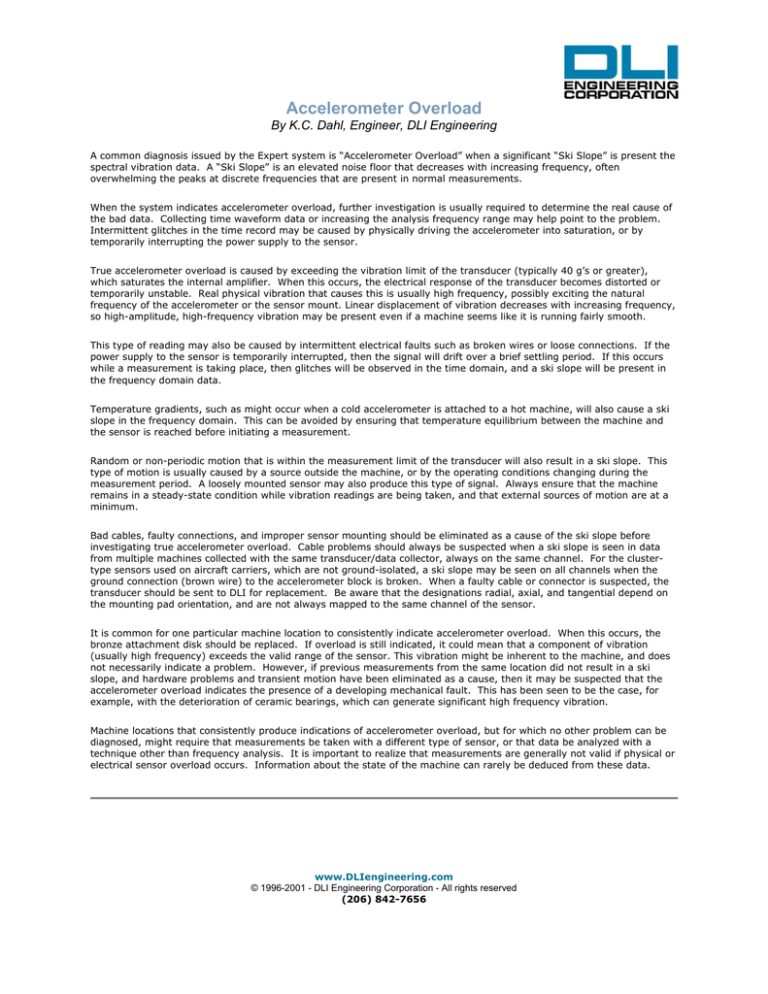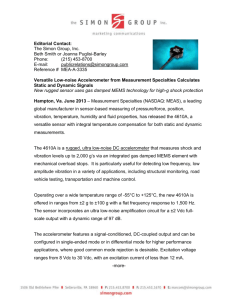
Accelerometer Overload
By K.C. Dahl, Engineer, DLI Engineering
A common diagnosis issued by the Expert system is “Accelerometer Overload” when a significant “Ski Slope” is present the
spectral vibration data. A “Ski Slope” is an elevated noise floor that decreases with increasing frequency, often
overwhelming the peaks at discrete frequencies that are present in normal measurements.
When the system indicates accelerometer overload, further investigation is usually required to determine the real cause of
the bad data. Collecting time waveform data or increasing the analysis frequency range may help point to the problem.
Intermittent glitches in the time record may be caused by physically driving the accelerometer into saturation, or by
temporarily interrupting the power supply to the sensor.
True accelerometer overload is caused by exceeding the vibration limit of the transducer (typically 40 g’s or greater),
which saturates the internal amplifier. When this occurs, the electrical response of the transducer becomes distorted or
temporarily unstable. Real physical vibration that causes this is usually high frequency, possibly exciting the natural
frequency of the accelerometer or the sensor mount. Linear displacement of vibration decreases with increasing frequency,
so high-amplitude, high-frequency vibration may be present even if a machine seems like it is running fairly smooth.
This type of reading may also be caused by intermittent electrical faults such as broken wires or loose connections. If the
power supply to the sensor is temporarily interrupted, then the signal will drift over a brief settling period. If this occurs
while a measurement is taking place, then glitches will be observed in the time domain, and a ski slope will be present in
the frequency domain data.
Temperature gradients, such as might occur when a cold accelerometer is attached to a hot machine, will also cause a ski
slope in the frequency domain. This can be avoided by ensuring that temperature equilibrium between the machine and
the sensor is reached before initiating a measurement.
Random or non-periodic motion that is within the measurement limit of the transducer will also result in a ski slope. This
type of motion is usually caused by a source outside the machine, or by the operating conditions changing during the
measurement period. A loosely mounted sensor may also produce this type of signal. Always ensure that the machine
remains in a steady-state condition while vibration readings are being taken, and that external sources of motion are at a
minimum.
Bad cables, faulty connections, and improper sensor mounting should be eliminated as a cause of the ski slope before
investigating true accelerometer overload. Cable problems should always be suspected when a ski slope is seen in data
from multiple machines collected with the same transducer/data collector, always on the same channel. For the clustertype sensors used on aircraft carriers, which are not ground-isolated, a ski slope may be seen on all channels when the
ground connection (brown wire) to the accelerometer block is broken. When a faulty cable or connector is suspected, the
transducer should be sent to DLI for replacement. Be aware that the designations radial, axial, and tangential depend on
the mounting pad orientation, and are not always mapped to the same channel of the sensor.
It is common for one particular machine location to consistently indicate accelerometer overload. When this occurs, the
bronze attachment disk should be replaced. If overload is still indicated, it could mean that a component of vibration
(usually high frequency) exceeds the valid range of the sensor. This vibration might be inherent to the machine, and does
not necessarily indicate a problem. However, if previous measurements from the same location did not result in a ski
slope, and hardware problems and transient motion have been eliminated as a cause, then it may be suspected that the
accelerometer overload indicates the presence of a developing mechanical fault. This has been seen to be the case, for
example, with the deterioration of ceramic bearings, which can generate significant high frequency vibration.
Machine locations that consistently produce indications of accelerometer overload, but for which no other problem can be
diagnosed, might require that measurements be taken with a different type of sensor, or that data be analyzed with a
technique other than frequency analysis. It is important to realize that measurements are generally not valid if physical or
electrical sensor overload occurs. Information about the state of the machine can rarely be deduced from these data.
www.DLIengineering.com
© 1996-2001 - DLI Engineering Corporation - All rights reserved
(206) 842-7656




